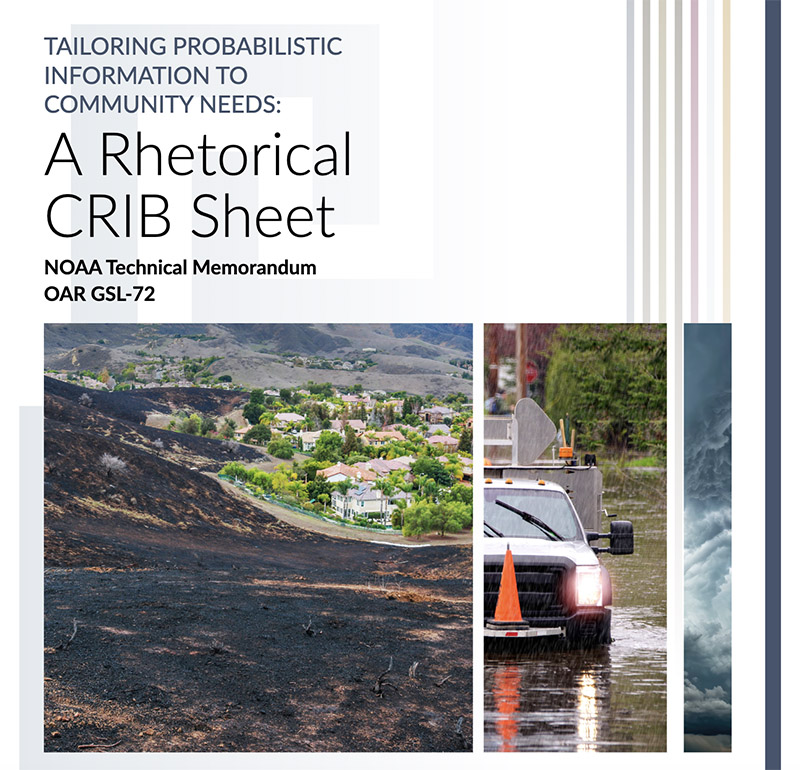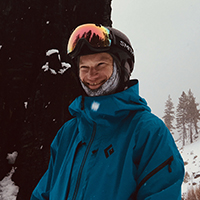Have You Noticed Something New in the Forecast?
Educational Videos on Probabilistic Forecasts
Users of National Weather Service forecasts may have noticed more probabilities in the weather information that they rely on every day. In addition to the “most likely forecast,” probabilistic information provides users with a view into the range of possible outcomes and the chances of each outcome taking place.
Forecasters can select and share videos that correspond to the type of weather hazard or probabilistic information contained in forecasts to help users get the most out of these forecasts. The videos are designed to be shared alongside probabilistic forecasts to help unpack why this information is provided and how it can support their decisions.
Videos are intended to be shared with a wide range of audiences, including partners and members of the public. The videos depict commonly used weather visuals to build familiarity and understanding of key concepts and graphics in probabilistic weather forecasting.
Using everyday scenarios that include snowfall, heavy rain, thunderstorms, hard freezes, and excessive heat, this series demonstrates how to apply probabilistic forecasts in daily decisions. These videos demonstrate how probabilistic information can strengthen community preparedness with an understanding of the range of possibilities in the forecast.
Shareable Videos on Probabilistic Weather Forecasts
Why do new weather forecasts show a range of possible outcomes?
“What’s all this extra information? I just want to know how much it will snow.” Our meteorologist explains why some forecasts go beyond the ‘most likely scenario’ and share different possible weather outcomes. She points out how valuable it can be when forecasts include probabilities of different weather scenarios.
Should I care about weather forecasts with a low chance of a severe event?
“If there is such a low chance, why should I care?” Our meteorologist responds to questions about low-probability events that could have a high impact, like flooding. She offers advice on how weather information that includes a range of possible outcomes can help people to be more prepared for high-impact events and to have a backup plan.
How can weather forecasts help me decide if it is safe to head out?
“Should we travel if there is a small chance of a lot of snow? Grandma wants to know if we are coming!” Our meteorologist helps us reflect on our own ‘dealbreaker’ conditions, or thresholds for safe travel, when there is a chance that the conditions will be hazardous. She reminds us that we already use probabilities in other areas of our life every day. Then, she helps us understand that forecasts that include percent chance encourage us to operate within our personal comfort zone, where we have a better chance of staying safe in bad weather.
Can I trust weather forecasts with the probability of thunderstorms?
“Why should I make a backup plan for thunderstorms when I don’t always see lightning?” Our meteorologist explains why we can’t predict the exact location where that lightning will strike. She responds to questions about trusting the forecast if previous ones have seemed “off” and points out how important backup plans can be.
Why do weather forecast maps show the probability of temperature?
“Wait – this map doesn’t show the predicted temperature – instead it shows the chance that it will freeze?” Our meteorologist clarifies the difference between maps that show the temperature forecast and those that show the percent chance of a hard freeze or excessive heat. She explains why forecasts that provide a range of possible outcomes are needed for different people across a community, and she helps us consider not only the impact that the weather might have on our own lives but also the possible impacts on others who are more vulnerable to the weather.

Tailoring probabilistic information to community needs: A rhetorical CRIB sheet
NOAA Technical Memorandum OAR GSL-72
This technical memorandum provides a rhetorical CRIB (Collect, Review, Identify, Build) sheet, with supporting rationale and resources, to help forecasters tailor probabilistic information to community needs via commonplaces (shared beliefs, norms, and values). This memorandum begins with an Introduction that discusses the genesis of the project that led to the rhetorical CRIB sheet, followed by a section dedicated to “Defining a Rhetorical Approach” in relation to probabilistic forecasting. We then share the one-page CRIB sheet for applying rhetorical commonplaces to probabilistic forecast scenarios. We end with supporting resources for enacting the steps outlined in the CRIB sheet. The immediate goal is helping forecasters integrate probabilistic information into weather communication in ways that are meaningful to the communities they serve. The ultimate goal is increasing communication and trust between forecasters and their communities, as resilient forecast communities are key to managing the growing risks associated with extreme weather events (Cross & LaDue, 2021).
Background on the Video Creation
For forecasters and other professionals: How to use these videos
With increased availability of probabilistic forecasts, public audiences and partners may need support to integrate this new type of forecast information into decision-making. This video series highlights the value and utility of probabilistic forecasts for preparedness. They are designed specifically to complement forecasts that include probabilities and discussion of uncertainty.
Here are some ways that forecasters can use these videos:
- Post them on social media alongside forecasts that include probabilistic information. Select videos that correspond to the weather event or type of probabilistic information that is shared.
- Include them in weather briefing presentations to partners or public audiences to unpack or underscore key points that you want to make about upcoming events (e.g., low chance/high impact events, ability to predict exactly where lightning will strike, probabilistic information portrayed spatially on maps, etc.).
- Link them in partner emails containing discussions of probabilistic forecasts.
Forecasters can select videos based on their themes and key probabilistic concepts:
- Video 1. Why do new weather forecasts show a range of possible outcomes?
- Key concept: What probabilistic forecasts are and why they are useful, illustrated using percent chance of accumulation and temperature.
- Weather setting: Forecasts for rain, snow, and freezing temperatures.
- Video 2. Should I care about weather forecasts with a low chance of a severe event?
- Key concept: Probabilistic forecasts that share the chance of a low-probability, high-impact event, using an example of preparedness for heavy rains.
- Weather setting: Flooding and areas of flash flood watch.
- Video 3. How can weather forecasts help me decide if it is safe to head out?
- Key concept: Forecasts showing the most likely, moderate, slight chance of accumulation both in a table and on a map.
- Weather setting: Snow accumulation forecasts.
- Video 4. Can I trust weather forecasts with the probability of thunderstorms?
- Key concept: Probabilistic forecasts inherently involve uncertainty, especially for certain weather events like lightning.
- Weather setting: Thunderstorm forecasts.
- Video 5. Why do weather forecast maps show the probability of temperature?
- Key concept: Maps can show the probability that temperatures will be above or below important thresholds for safety.
- Weather setting: Excessive heat and hard freezes.
Our research topics and outcomes
Our research on Meteorology and Environmental Rhetorics (MEANDER) is focused on providing operational forecasters with evidence-based practices that are based on input from the communities that use weather information, gleaned using rhetorical methods that can capture community risk thresholds from open-ended community comments on surveys and social media.
To support communities to make strong decisions with this new type of weather forecast information, our research group has conducted a series of surveys in collaboration with five Weather Forecast Offices in the Western US to gather input on preferences for communicating probabilistic forecasts visually. Our surveys gathered input from both NWS partners and public audiences about risk decisions in response to graphics describing weather hazards. We identified community risk thresholds that give forecasters tools to build trust by incorporating community concerns into weather forecasts.
How our research shaped the videos
This series features short, animated videos with dialog between a community member and a meteorologist, who appears in a callout bubble to answer the community member’s questions. Through their dialog, the videos elucidate key concepts and demonstrate how probabilistic forecast information can be incorporated into decision-making.
Our surveys helped to identify key questions that partners and stakeholders have while using probabilistic forecasts, and these shaped the concerns that the community member expresses in the videos, to which the meteorologist responds. By incorporating these questions, we go beyond the technical discussion of the forecast, responding to communities’ concerns and including them in the discussion to advance understanding and build trust.
Conventional weather forecasts include objective thresholds based on the damage that wind does to structures at certain speeds, for instance. Our surveys gathered community risk thresholds related to weather hazards, which are “go/no-go” tipping points. For example, how hot is too hot to go for a walk? How much snow is too much to commute to work? We incorporate these community risk thresholds to complement objective thresholds because they influence personal decisions around safety or risk reduction.
Team MEANDER and acknowledgements
The MEANDER Team
|
Kathryn Lambrecht (ASU) |
Lynda Olman (UNR) |
Anne Heggli (DRI) |
|
Meghan Collins (DRI) |
Zach Tolby (NOAA) |
Ben Hatchett (NOAA) |
Video Creation Roles
|
Video Animations |
Voice actor |
Voice actor |
Production: Meghan Collins. Content experts: Zach Tolby, Anne Heggli, Kathryn Lambrecht, Ben Hatchett, and Lynda Olman
This project was funded by the National Oceanic and Atmospheric Association Weather Program Office Social Sciences Program under Grant #NA21OAR4590208.
Learn more: Publications, conferences, and media
Publications:
Mysore, P. and K Lambrecht. 2025. Visualizing heat risk: Infographics, eye tracking, and memorability. Technical Communication, forthcoming, February 2025.
Hatchett, B., J. Vickery, L. Jamie, Z. Tolby, T. Jones, T. Skinner, S. Patrick, E. Wells, and K. Thiem. 2024. Fire Weather Testbed Evaluation #001: The Warn-on-Forecast System for Smoke. Global Systems Laboratory (U.S.); National Severe Storms Laboratory; Cooperative Institute for Research in the Atmosphere (Fort Collins, Colo.);Cooperative Institute for Severe and High-Impact Weather Research and Operations. NOAA technical memorandum OAR GSL ; 68
DOI : https://doi.org/10.25923/nd0m-4j95
Lambrecht, K. 2024. Heat vulnerability mapping: Designing visual tools that effectively communicate risk. Communication Design Quarterly, 16-26, 2024. DOI: 10.1145/3658438.3658441
VanderMolen, K. and Hatchett, B.J., 2024. Bridging Risk Communication and Health Literacy to Improve Health Outcomes Related to Heat: Oxford Research Encyclopedias, https://doi.org/10.1093/acrefore/9780199389407.013.431
Heggli, A., B. Hatchett, Z. Tolby, K. Lambrecht, M. Collins, L. Olman, and M. Jeglum, 2023. Visual Communication of Probabilistic Information to Enhance Decision Support. Bull. Amer. Meteor. Soc., 104, E1533–E1551, https://doi.org/10.1175/BAMS-D-22-0220.1.
VanderMolen, K., Kimutis, N., and Hatchett, B.J., 2022. Increasing the reach and effectiveness of heat risk education and warning messaging, International Journal of Disaster Risk Reduction, 82, 103288, https://doi.org/10.1016/j.ijdrr.2022.103288
Hatchett, B.J., AM Rhoades, DJ McEvoy. 2022. Monitoring the Daily Evolution and Extent of Snow Drought. Natural Hazards and Earth System Sciences, 22, 869–890, https://doi.org/10.5194/nhess-22-869-2022
Lambrecht, K., VanderMolen, K., Hatchett, B.J., Feldkircher, B., 2021. Identifying Community Values Related to Heat: Recommendations for Forecast and Health Risk Communication. Geoscience Communication, 4, 517–525, https://doi.org/10.5194/gc-2021-12
Hatchett, B.J., Benmarhnia, T., Guirguis, K., VanderMolen, K., Gershunov, A., Kerwin, H., Khlystov, A., Lambrecht, K.M., Samburova, V., 2021. Mobility data aids assessment of human responses to extreme environmental conditions. The Lancet Planetary Health, 5(10), e665-e667, https://doi.org/10.1016/S2542-5196(21)00261-8
Bambach, N.E., Rhoades, A.M., Hatchett, B.J., Jones, A.D., Ullrich, P.A., and Zarzycki, C.M., 2021. Projecting climate change in South America using variable-resolution CESM: An application to Chile. International Journal of Climatology, 42(4), 2514-2542, doi:10.1002/joc.7379
Lambrecht, K.M., B.J. Hatchett, L. Walsh, M. Collins, and Z. Tolby, 2019. Improving Visual Communication of Weather Forecasts with Rhetoric. Bulletin of the American Meteorological Society, 100, 557-563, doi:10.1175/BAMS-D-18-0186.1
Conference activity:
Lambrecht, K., L. Olman, M. Collins, A. Heggli, B. Hatchett, and Z. Tolby. 2024. Building Community through Weather Hazard Forecasting: A Collaboration between the National Weather Service and Environmental Rhetoricians
Collins, M., M. Mahmoud, A. Heggli, B. Hatchett, K. Lambrecht, L. Olman, and Z. Tolby. 2024. MEANDER educational motion graphics: A multidisciplinary approach to creating impactful communication products. Presentation to the Association for Rhetoric of Science, Technology, and Medicine. May 24, 2024. Denver, CO.
Lambrecht, K., L. Olman, M. Collins, A. Heggli, B. Hatchett, and Z. Tolby. 2024. Identifying Risk Thresholds to Promote Increased Safety in Extreme Weather Communication. Presentation to the Association for Rhetoric of Science, Technology, and Medicine. May 24, 2024. Denver, CO.
Heggli, A. E., Hatchett, B. J., Tolby, Z., Lambrecht, K., Collins, M. J., Jeglum, M. E. 2024. Visual Communication of Probabilistic Information to Enhance Decision Support, J13.5. AMS 104th Annual Meeting: Baltimore, MD & Online, January 28, 2024-February 1, 2024. https://ams.confex.com/ams/104ANNUAL/meetingapp.cgi/Paper/437208
Collins, M., Z. Tolby, K. Lambrecht, I. Wadhwa, B. Hatchett, A. Heggli, L. Olman. 2023. Advancing probabilistic forecast communication: A partnership with five Western US NWS forecast offices for improved visualizations and graphics. American Meteorological Society: Denver, Colorado
Lambrecht, K., B. Hatchett, L. Olman, M. Collins, Z. Tolby, A. Heggli, and M. Wadhwa. 2022. Identifying Community Risk Thresholds to Encourage Equitable Communication of Geohazards in Five Communities. AGU Fall Meeting: Chicago, Illinois.
Media:
Rocky Mountain PBS (article and video): AI is ready to help fight wildfires, and the ‘WindNinja’ is next
Washington Post: As wildfires rage, forecasters test new way to warn people near flames
NOAA Research: NOAA tests next-generation wildfire detection and warning tools
NOAA NESDIS: Fire Weather Testbed Q&A Featuring Zach Tolby
Denver Post: How AI and satellite imaging are helping detect wildfires in Colorado before they grow








